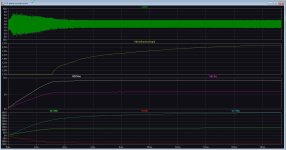In their application range litz wire exhibits less losses then solid wire - otherwise no one would use this.Litz may have some benefits, but I find it harder to source for a DI,Y and the copper-density is lower than normal copper-wire so conduction (for low freq?) should be higher?
Availability is certainly an issue, but not a criterion when looking for the best solution.
btw, I would tend to use identical wire type for inductor and transformier - or omit the external inductor using a loose coupled transformer.
I have also a slight out of topic question.
I have sim a LCC for high voltages and filament voltages for tubes, I have to wind
it, but do not now what windings have to go first, I think the filament fvoltage of 12,6
volts who is regulated have to get closest to primary and then the 120+120v and as last the 350 volts.
somebody now the answer.
thanks.
I have sim a LCC for high voltages and filament voltages for tubes, I have to wind
it, but do not now what windings have to go first, I think the filament fvoltage of 12,6
volts who is regulated have to get closest to primary and then the 120+120v and as last the 350 volts.
somebody now the answer.
thanks.
Attachments
The reason for litz wire is higher Q in the inductor - different inductors may have different requirements for their Q - a resonant converter clearly needs high Q in the resonant transformer, the clue is in the name, but is that needed in every inductor in the system? Indeed for filtering out high frequencies low Q is not necessarily an issue - consider EMI rejection ferrites which are principally resistive in the HF impedance...
Which is correlated to real losses under load conditions. I developed a 400W LLC-converter and found lowest transformer temperature increase with litz wire. This experience was significant with clock rates <100kHz. Higher clock frequencies will show different ways to best efficiency.The reason for litz wire is higher Q in the inductor -
Is litz wire not meant to stay below the skineffect for each wire? when have a lot of strands the skineffect
is totaly gone, but is this worth it.
I did 2 years ago a welding inverter, just choose separate wires slightly smaller then the desired skin depth and did very fine.
It was quite thick, what was is that the wire is thicker then a litz because these have much more wires keeping it compact
that is the only reason i see for using it.
is totaly gone, but is this worth it.
I did 2 years ago a welding inverter, just choose separate wires slightly smaller then the desired skin depth and did very fine.
It was quite thick, what was is that the wire is thicker then a litz because these have much more wires keeping it compact
that is the only reason i see for using it.
An LLC needs an optimum ratio of magnetizing inductance to leakage inductance (called the "K" ratio) for good performance.. K ratios of 3-4 generally work well. For a situation where a separate resonating inductor is used, design the main transformer for the lowest possible leakage inductance and gap it for the optimum value of magnetizing inductance. The resonating inductor (the "leakage" portion) can be wound using a standard ferrite core using Litz wire. Power integrations (www.power.com) has a design tool for their integrated LLC solution that is useful for designing a practical LLC converter, and has a section used for a designing with a separate resonating inductor. Don't go too crazy high for the operating frequency.
Nope. It's for elimination of a proximity effect to put every wire in the same field conditions. Check Dowell curve. Distribution transformers working on main's frequency utilize transposed wire.Is litz wire not meant to stay below the skineffect for each wire?
I refer you to the Wikipedia article: https://en.wikipedia.org/wiki/Litz_wire#Principle_of_operation - yes its to reduce skin-effect losses - it does this by replacing one fat conductor with many thin conductors.
If you wanna win a lottery you have to buy a ticket, or better a lot of, i.e. read something, and not EE for dummies. Real Litz is twisted in bundles of 7, then 7w bunldes are wound in bundles of 7x7, 7x49...7x343 and so on. It seems though wire manufacturers have nothing better to do. Just use higher gauge wire as speculated. For instance:
https://eepower.com/technical-articles/modern-magnetics-design-winding-proximity-loss/
https://core.ac.uk/download/pdf/91983036.pdf
https://hrcak.srce.hr/file/247269
https://eepower.com/technical-articles/modern-magnetics-design-winding-proximity-loss/
https://core.ac.uk/download/pdf/91983036.pdf
https://hrcak.srce.hr/file/247269
- Home
- Amplifiers
- Power Supplies
- LLC Converter maximum gap in core
